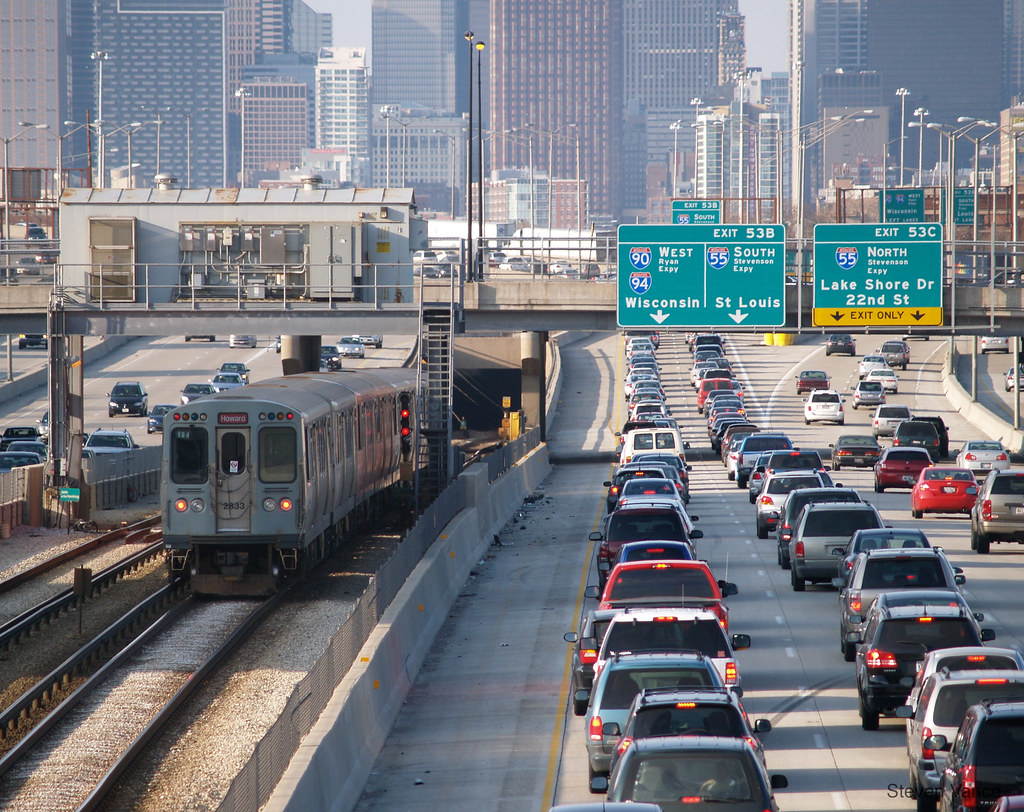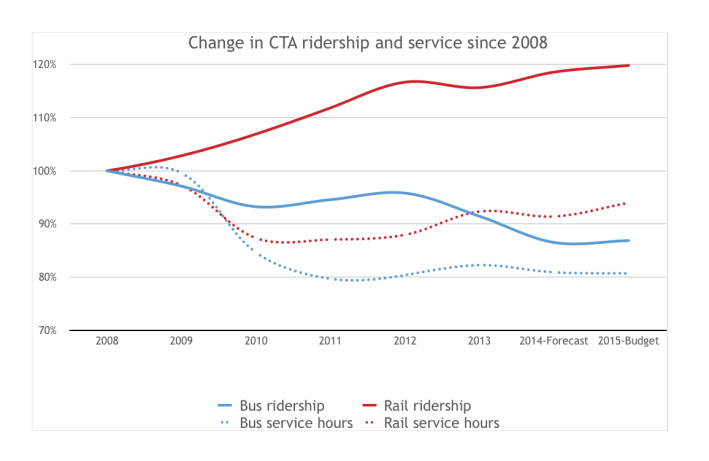
Cook County's new "Long Range Transportation Plan," released last week, is the first such document published since 1940 and is a policy platform that will guide decisions about transportation spending for the next 24 years. To the credit of county officials, the plan voices strong support for improving walking, biking, and transit, which represents a major change for a governmental body that has focused on facilitating driving for many decades. However, I'd argue that the document, called "Connecting Cook County," falls short of being a plan when it come to setting concrete goals for promoting sustainable transportation, and that's a missed opportunity.
On the plus side, the language of the report acknowledges the mistakes of the past and emphasizes the benefits of active transportation. "Cook County, like the rest of the country, has long prioritized the automobile as the preferred mode of personal travel," it states. It outlines the safety, mobility, and health benefits of better pedestrian and bike facilities and commits to improving this infrastructure across the county.
In particular, the document calls transit "the single-most important" mode for helping Cook County compete with peer urban areas around the world that offer businesses and residents "realistic, high-quality" transportation options. It argues that public transportation is also a way to shore up the county's economic development strategies.
According to county spokesperson Becky Schlikerman, the document wasn't intended to be a check list of goals to accomplish over the next few years, but rather a set of general policy guidelines. "The Long Range Transportation Plan is a long-term policy document that will serve as a roadmap for transportation priorities and policies for decades to come," Schlickerman said "This document is not a list of projects that will be completed in the short-term."
But for the $1.4 million it cost to create the report, Cook County county taxpayers – who provided feedback in 2014 – should have gotten something more specific. Effective transportation plans set measurable goals, detail objectives on how to achieve them, and detail current statistical benchmarks against which future achievements will be measured.
Despite the fuzzy targets, the policy platform is a big move in the right direction for an a county whose transportation policies have long been stuck in a 1950s mindset. Its goals essentially match the priorities set forth in the Chicago Metropolitan Agency for Planning's comprehensive GO TO 2040 plan. That document calls on counties and municipalities in northeast Illinois to make measurable improvements over the next 24 years, with specific goals like doubling transit ridership, improving access to jobs, and reducing pollution caused by highway driving.
Admirably, Connecting Cook County states that supporting transit-oriented development – mixed-use development around transit stations – is the single most important investment the county can make to strengthen the transportation network and make the vast county a more desirable place to live. The document explains that "improvements to be supported by the department include sidewalks, facilities for bicycles, and community plazas." Since there are over 260 CTA and Metra rail stations in the county, that strategy could indeed have widespread benefits.
The report doesn't have a lot of specifics on the kinds of projects Cook County should implement, but it does include a few examples. It states that the county's Department of Transportation and Highways "will assist Pace in its efforts to provide expedited bus service on arterial roads and expressways," and coordinate traffic signals and transit signal priority for Pace's Arterial Rapid Transit project.
Where it falls short
One issue with Connecting Cook County is that some of the statistics it uses are outdated, which may have resulted in some misinformed policies. It includes stats on county residents' travel habits that are based on CMAP's Travel Tracker, a detailed survey of all kinds of household trips, which supplements U.S. Census commuting figures, which only cover work commutes. The Travel Tracker survey was last conducted in 2008, but the county document argues that "the order of magnitude and character of those trips are not likely to have changed materially" since then.
However, downtown Chicago has gained tens of thousands of jobs, and thousands of new residences since 2008, CTA rail ridership has grown 20 percent while bus ridership has fallen 12 percent, and the number of people walking and biking has increased. Therefore the "character and magnitude" of urban travel has probably changed significantly over the last eight years.

Another goal from Connecting Cook County is increased transportation funding. The document notes that the county recently made a major move in that direction. "In 2015 Cook County took the unprecedented step of expanding transportation funding by ending the long-standing practice of diverting motor fuel tax funds to other uses," it states. As a result, next year the county will have an additional $45 million per year to fund multi-modal transportation projects.
The reports adds that, as a strategy to raise additional transportation funding, county officials should advocate for an increase in the state gas tax. It's currently a flat tax of about 20 cents a gallon, which hasn't been raised since 1991. As a result the revenue raised each year has 40 percent less purchasing power than it did a quarter-century ago.
To address this problem, the document recommends "[enacting] a reliable and consistent source of transportation capital funding." That strategy sounds a lot like Transit Future, a campaign launched in 2014 by the Active Transportation Alliance and the Center for Neighborhood Technology with the goal of creating a new dedicated funding stream for transit infrastructure at the county level, modeled after a similar effort in Los Angeles. Cook County president Toni Preckwinkle and several county commissioners have endorsed Transit Future, but the campaign isn't even mentioned in Connecting Cook County.
Another possible strategy to transportation funding was also omitted from the new document. Early in Connecting Cook County's process, a "scenario plan" for different concepts were developed. One of the four possible scenarios would have overhauled the Illinois Department of Transportation's current funding split, in which 55 percent of state transportation funding is awarded to downstate communities and only 45 percent goes to the Chicago region.
CMAP has argued that state transportation funding should instead be based on need and performance, taking into account that Chicagoland is Illinois' main economic engine. However, the state funding reboot scenario wasn't included in Connecting Cook County. Asked about this omission, Schlikerman responded that "The idea was to have a flexible document because of anticipated changes on how infrastructure will be funded."
The new document's discussion of increasing the gas tax should have also included gas tax alternatives, specifically a Vehicle Miles Traveled tax. This approach would address the issue that drivers of hybrid and electric cars are contributing relatively little or no gas tax, but these vehicles still put wear and tear on roads.
Again, it's great that "Connecting Cook County" radically changes the county's long-held windshield perspective and aligns county policy with the existing GO TO 2040 plan. However, because the transportation platform mostly lacks specific goals and measures it will be difficult to gauge whether the document has a positive impact on regional transportation.


